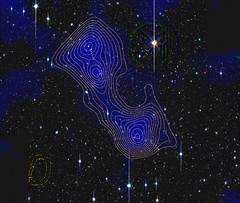| Abell 222 & Abell 223 with dark matter filament (Photo credit: Jörg Dietrich) |
Over the last couple of weeks I finally had the opportunity to engage in one of my favorite Aspen, Colorado activities, attending the Nick and Maggie DeWolf Public Lectures series hosted by the Aspen Center for Physics.
These free lectures allow physicists attending conferences at the Aspen Center for Physics to share their cutting-edge research with Aspen locals and visitors in such a way as to impart their knowledge on a level understandable to non-physicists.
Here are the events I've attended so far:
- Seeking Dark Matter – presented by astrophysicist, James E. Peebles (Princeton University)
- Neutrino Monologues – presented by Deborah Harris (Fermilab and the University of Rochester)
Even “dumbed down”, this kind of information is, by its nature, often difficult for the general public to comprehend (and apparently sometimes even for the physicists themselves).
I personally find the presentations to be at the same time very informative, educational, baffling, and humbling; and like many of the other attendees, I often wonder why this knowledge is important to ordinary people like me.
The answers I have found fall into three main categories:
- Technological spin-offs
- Technical literacy
- Entertainment/satisfying our natural human curiosity
Technological Spin-Offs
Technological spin-offs are products, services, or techniques developed for one industry that result from the research and technology acquired while studying another, somewhat unrelated, phenomenon.
- The National Aeronautics and Space Administration (NASA) is perhaps the most well-known catalysts of such spin-offs. Their scientific endeavors have given us such technology as photocatalytic solutions that create self-cleaning surfaces, advanced lubricants, medical technology and polymer fabrics.
Here are some more examples of NASA’s spin-off technology:
http://spinoff.nasa.gov/
http://www-pao.ksc.nasa.gov/kscpao/nasafact/spinoffs.htm
http://www.brighthub.com/science/space/articles/42942.aspx
- The Conseil Européen pour la Recherche Nucléaire (European Organization for Nuclear Research or CERN) also has provided the technology for many spin-offs. Examples include sterilization - food, medical, sewage, cancer therapy, nuclear magnetic resonance imaging and many more practical applications.
- Technological Spin-Offs related to the Ski/Snowboard and other outdoor-related industries:
winter sports mecca, I was very interested in finding out about spin-offs related to
the skiing and other outdoor related industries.
- Space Age fabric that is used in ski apparel to keep wearers comfortable in
variable temperature and weather settings
- Liquid metal alloys with the elasticity of plastics and twice the strength of
titanium – used in products such as tennis racquets, baseball bats and golf
clubs
- Tempor Memory Foam – used for cushioning in footwear and protective sports
gear
- “Smart” Ski Boots - allows the ankles to have a greater front-to-back range of
motion while retaining strong stability side-to-side.
- Ski Goggles - fogging prevention
- Eye ware with scratch-resistant lenses
Research Leads to an Increase in Overall Technical literacy
We live in a world driven by science, creating the need for people to learn how science, technology, engineering and even business work together in order to “…participate intelligently and thoughtfully in the world around them." (http://www.nsf.gov/statistics/seind04/c7/c7s2.htm). This has especially important implications for decision makers in business, government and the media.
Research in cosmology, particle physics, and really all scientific fields, creates and stimulates the environment needed to achieve these ends.
Scientific Research Entertains and Satisfies Our Natural Human Curiosity
So it comes down to this, we human beings are curious by nature, and we need to develop experimental technology to satisfy this curiosity. Along the way, this work often results in the acquisition of practical technology (related and unrelated), and a framework for education in general, that also allows us to make our lives “better” at the same time.
Aspen, Colorado activities like the various lecture series hosted by the Aspen Center for Physics generously provide information about cutting edge scientific research. This serves not only to entertain and educate the general public, but to encourage the world’s leading scientists to continuing pursuing knowledge that will ultimately enrich and improve our lives as well.
That is why dark matter matters.
Related articles
- Consumer Spinoffs (spinoff.nasa.gov)
- How did NASA make snow skiing safer? (science.howstuffworks.com)
- How does astronomy benefit humankind? (curious.astro.cornell.edu)
- Honoring the Mars Exploration Team and How You... (parents.com)
Related blogs
- Assorted Aspen (assortedaspen.com)


No comments:
Post a Comment